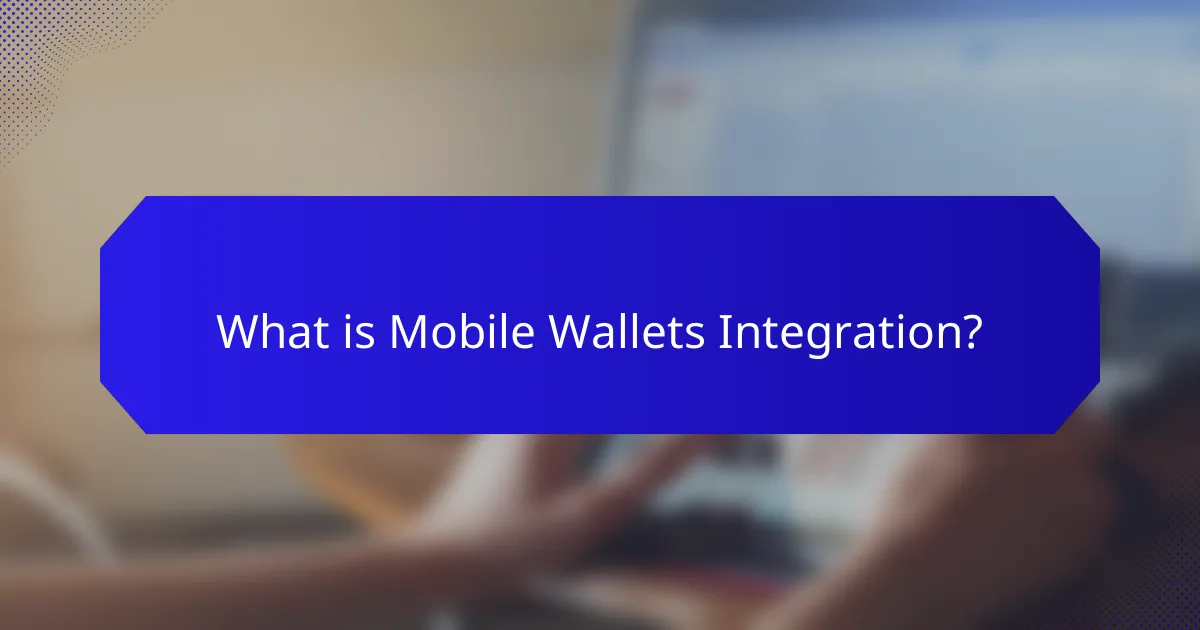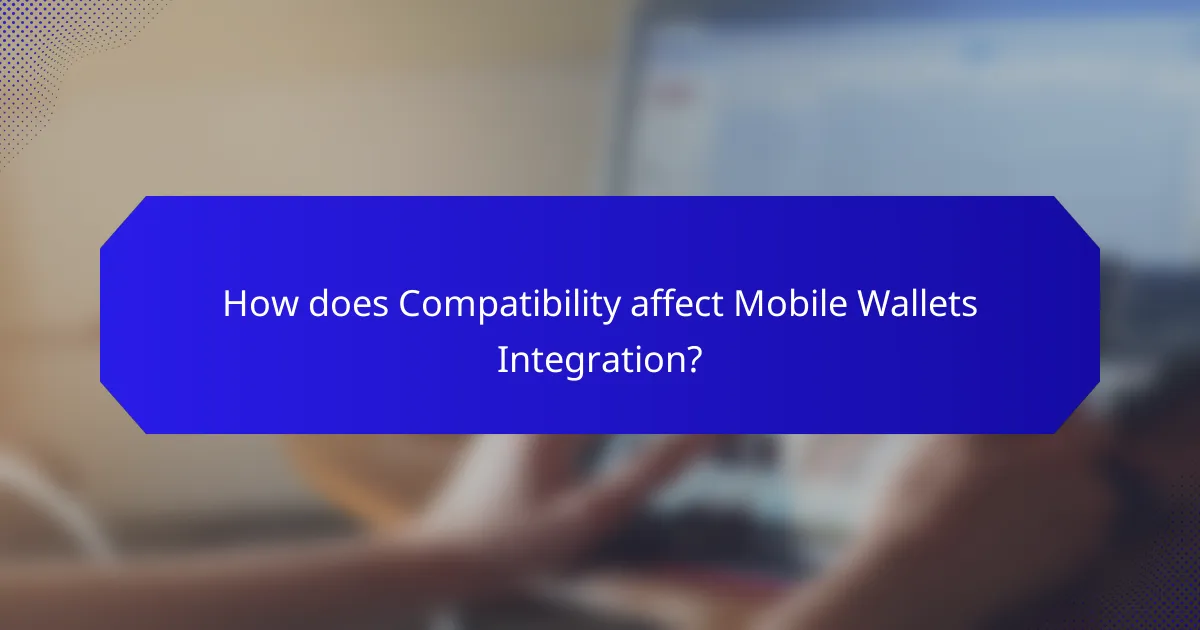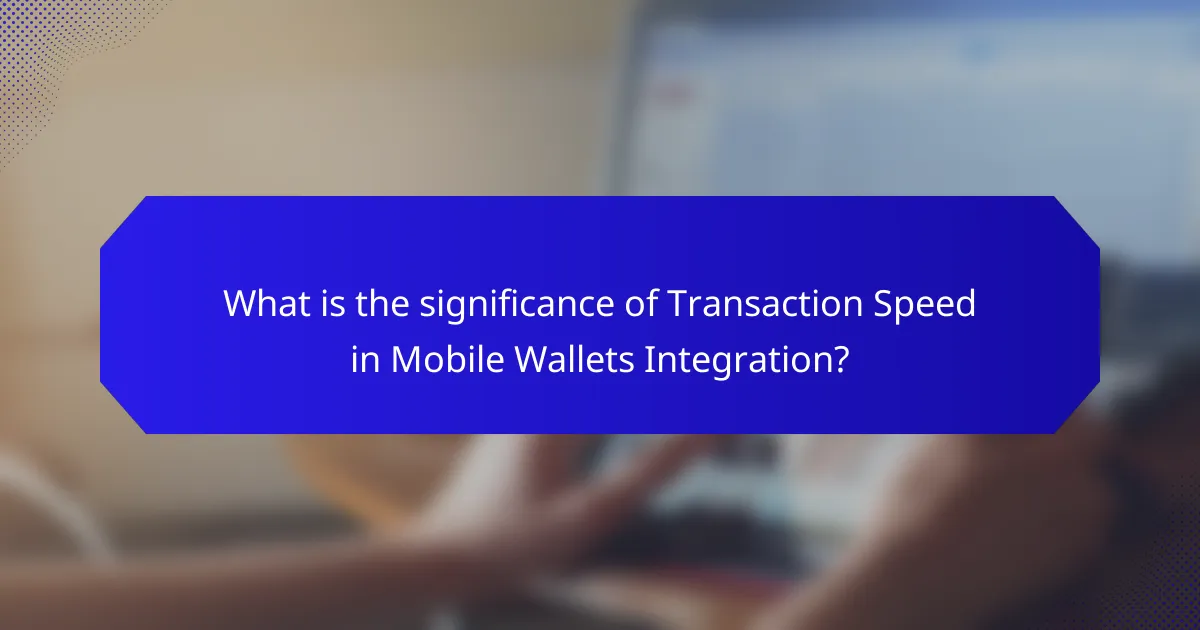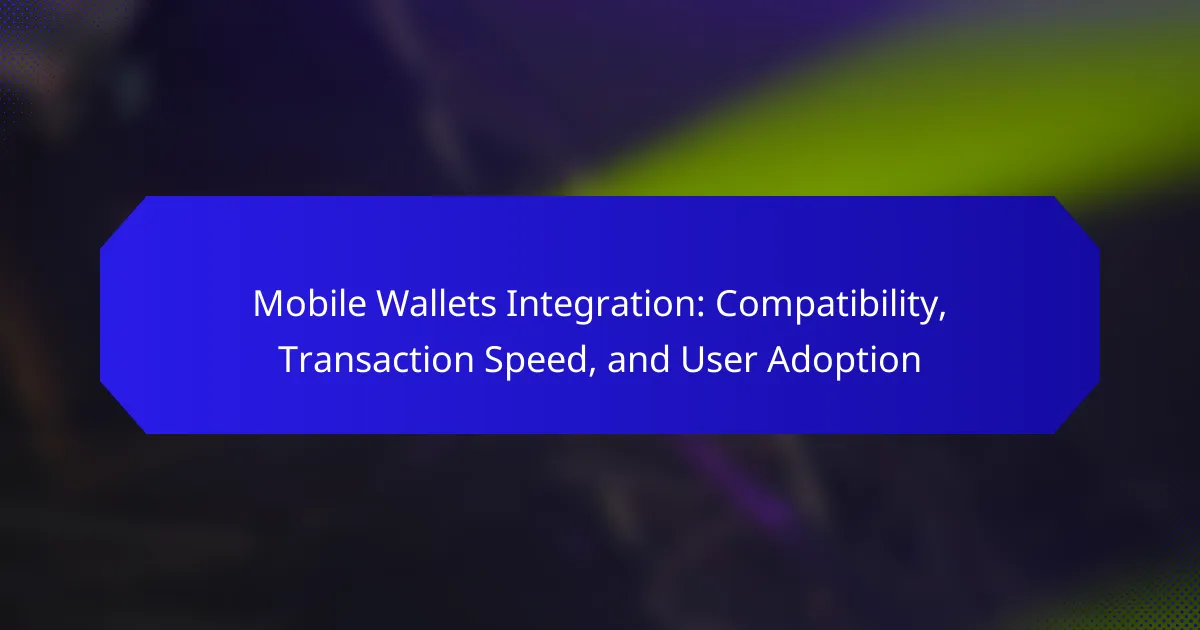Mobile wallet integration involves incorporating mobile wallet functionality into various platforms and services, enabling users to make payments, store digital currencies, and manage financial transactions via mobile devices. This process connects mobile wallets with payment gateways, e-commerce sites, and point-of-sale systems, supporting multiple payment methods such as credit cards, bank transfers, and cryptocurrencies. Key factors influencing successful mobile wallet integration include compatibility across devices and payment platforms, which enhances user satisfaction and adoption rates, and transaction speed, which directly affects user experience by reducing wait times. With the global mobile wallet market projected to exceed $7 trillion by 2025, understanding these elements is critical for maximizing user engagement and trust in mobile wallet solutions.

What is Mobile Wallets Integration?
Mobile wallets integration refers to the process of incorporating mobile wallet functionality into various platforms and services. This integration allows users to make payments, store digital currencies, and manage financial transactions through their mobile devices. It typically involves connecting mobile wallets with payment gateways, e-commerce sites, and point-of-sale systems. Mobile wallets can support various payment methods, including credit cards, bank transfers, and cryptocurrencies. According to a report by Statista, the global mobile wallet market is expected to reach over $7 trillion by 2025, highlighting the growing adoption and importance of this technology in everyday transactions.
How does Mobile Wallets Integration function in digital transactions?
Mobile wallets integration enables users to conduct digital transactions through their mobile devices. This process involves linking a user’s bank account or credit card to a mobile wallet application. When a transaction is initiated, the mobile wallet securely transmits payment information to the merchant. This is done using technologies like Near Field Communication (NFC) or QR codes.
Security is enhanced through encryption and tokenization, which protect sensitive data during transmission. Additionally, mobile wallets often utilize biometric authentication for added security. According to a report by Statista, the mobile payment market is expected to reach over $4.5 trillion by 2023, indicating widespread adoption.
The integration of mobile wallets simplifies the payment process, making it faster and more convenient for users. This functionality supports various types of transactions, including in-store purchases, online shopping, and peer-to-peer payments.
What technologies are involved in Mobile Wallets Integration?
Mobile wallets integration involves several key technologies. These include Near Field Communication (NFC) for contactless payments. NFC enables secure transactions between devices at close range. Additionally, QR codes are used for scanning payments. They provide an alternative to NFC for initiating transactions. Payment gateways facilitate the processing of transactions securely. They connect mobile wallets to financial institutions. Tokenization is another critical technology. It replaces sensitive card information with unique identifiers. This enhances security during transactions. Finally, application programming interfaces (APIs) are essential. APIs allow mobile wallets to communicate with various services. Together, these technologies create a seamless mobile payment experience.
How do different mobile wallets interact with payment systems?
Different mobile wallets interact with payment systems through APIs and payment gateways. These interfaces facilitate the transfer of payment information between the wallet and the merchant’s system. Major mobile wallets like Apple Pay and Google Pay utilize Near Field Communication (NFC) technology for contactless transactions. This technology allows users to make payments by simply tapping their devices at compatible terminals. Additionally, mobile wallets often support multiple payment methods, including credit cards and bank transfers. This versatility enhances user convenience and broadens acceptance among merchants.
For example, a study by Statista in 2022 indicated that mobile wallet transactions are projected to reach $12 trillion globally by 2025. This growth reflects increasing integration with various payment systems. Furthermore, mobile wallets often incorporate security features like tokenization and biometric authentication. These features protect user data during transactions, making mobile wallets a preferred choice for consumers.
What are the key benefits of Mobile Wallets Integration?
Mobile wallets integration offers several key benefits. It enhances transaction speed, allowing users to complete payments quickly. Research shows that mobile wallet transactions can be completed in seconds. This efficiency improves customer satisfaction and encourages repeat purchases.
Integration also increases compatibility with various payment systems. Mobile wallets can work with multiple platforms, making them versatile for users. This broad compatibility attracts a wider audience.
Additionally, mobile wallets improve security for transactions. They often use encryption and tokenization to protect user data. According to a study by Juniper Research, mobile wallets reduce fraud by up to 50%.
Lastly, they facilitate better user adoption. Consumers are increasingly comfortable with digital payments. A report from Statista indicates that mobile payment users are expected to reach 1.31 billion by 2023. This growing trend highlights the importance of mobile wallet integration for businesses.
How does Mobile Wallets Integration enhance customer experience?
Mobile wallets integration enhances customer experience by providing convenience and speed in transactions. Users can make payments quickly without needing physical cards or cash. This integration allows for seamless transactions across various platforms and devices. Research shows that mobile wallet users report higher satisfaction rates due to reduced checkout times. According to a study by Statista, 60% of consumers prefer mobile wallets for their ease of use. Additionally, mobile wallets often include features like loyalty programs and discounts, adding value to the customer experience. Overall, mobile wallets streamline the purchasing process, making it more efficient for users.
What cost savings can businesses expect from Mobile Wallets Integration?
Businesses can expect significant cost savings from Mobile Wallets Integration. This integration reduces transaction fees associated with traditional payment methods. Mobile wallets typically charge lower fees compared to credit card processors. Businesses also save on hardware costs, as mobile wallets require less physical infrastructure. Additionally, integration can streamline payment processes, leading to reduced labor costs. Faster transactions can improve customer turnover rates, enhancing revenue. Research shows that businesses adopting mobile wallets see an average savings of 2-3% on transaction costs. These savings contribute to overall operational efficiency and profitability.

How does Compatibility affect Mobile Wallets Integration?
Compatibility significantly affects mobile wallets integration by determining how well different systems can work together. When mobile wallets are compatible with various devices and payment platforms, users experience seamless transactions. This compatibility enhances user satisfaction and encourages wider adoption. For instance, studies show that 70% of users prefer mobile wallets that integrate easily with their banking apps. Additionally, compatibility with multiple operating systems, like iOS and Android, broadens the user base. The lack of compatibility can lead to transaction failures, which negatively impacts user trust and retention. Therefore, ensuring high compatibility is crucial for successful mobile wallet integration.
What factors influence the compatibility of mobile wallets?
The compatibility of mobile wallets is influenced by several key factors. These factors include the operating systems they support, such as iOS and Android. Integration with payment networks like Visa and Mastercard also plays a crucial role. Security protocols, including encryption and tokenization, affect compatibility. Additionally, user interface design impacts how well mobile wallets work across devices. Merchant acceptance is another significant factor, as not all retailers support every mobile wallet. Lastly, regulatory compliance can influence which wallets are compatible in certain regions.
How do operating systems impact Mobile Wallets Integration?
Operating systems significantly impact mobile wallets integration by determining compatibility and functionality. Each operating system, such as Android or iOS, has unique security protocols and APIs. These protocols dictate how mobile wallets can interact with devices. For instance, Android supports various payment methods through its Google Pay API. In contrast, iOS uses Apple Pay, which has stricter guidelines for integration.
Additionally, operating systems influence transaction speed. Systems with optimized payment processing capabilities can enhance user experience. For example, iOS devices often have faster transaction times due to their efficient hardware-software integration.
User adoption is also affected by operating systems. Users are more likely to adopt mobile wallets that are seamlessly integrated with their existing OS. According to a 2022 study by Juniper Research, 60% of users prefer wallets that align with their device’s operating system. Thus, the choice of operating system plays a crucial role in the success of mobile wallet integration.
What role do payment gateways play in compatibility?
Payment gateways play a critical role in compatibility by facilitating seamless transactions between mobile wallets and merchants. They act as intermediaries that process payment information securely. This ensures that various payment methods are accepted across different platforms. Payment gateways support multiple currencies and transaction formats. This flexibility enhances user experience and broadens market reach for businesses. Compatibility is further strengthened by the integration of APIs that connect mobile wallets with payment gateways. Statistics show that 70% of consumers prefer businesses that offer diverse payment options. Thus, effective payment gateways are essential for successful mobile wallet integration.
Why is compatibility important for user adoption?
Compatibility is crucial for user adoption because it ensures that mobile wallets function seamlessly across various devices and platforms. When users can easily integrate a mobile wallet with their existing technology, they are more likely to adopt it. Studies show that 70% of users abandon apps that are not compatible with their devices. Compatibility reduces friction in the user experience. It allows for smooth transactions and enhances user satisfaction. When users encounter fewer technical issues, they tend to trust and rely on the service more. Therefore, compatibility directly influences the success of mobile wallet adoption.
How does compatibility affect user trust in mobile wallets?
Compatibility significantly affects user trust in mobile wallets. When mobile wallets are compatible with various devices and payment systems, users feel more secure in their transactions. A study by PwC found that 67% of consumers are more likely to trust a mobile wallet that works seamlessly across multiple platforms. Compatibility ensures that users can access their wallets on different devices without issues. This reliability fosters a sense of security and confidence in using the wallet for transactions. Additionally, compatibility with well-known payment providers can enhance trust further. Users are more likely to adopt wallets that integrate with familiar services. This integration reduces perceived risks associated with using less recognized platforms.
What are the consequences of poor compatibility for businesses?
Poor compatibility can lead to significant consequences for businesses. It often results in transaction failures, causing lost sales opportunities. Customers may experience frustration with payment processes that do not work seamlessly. This dissatisfaction can lead to decreased customer loyalty and negative brand perception. Additionally, businesses may incur extra costs related to troubleshooting and fixing compatibility issues. According to a study by the Harvard Business Review, companies lose up to 30% of their revenue due to poor customer experiences. Ultimately, poor compatibility can hinder a business’s growth and competitiveness in the market.

What is the significance of Transaction Speed in Mobile Wallets Integration?
Transaction speed is crucial in mobile wallets integration as it directly impacts user experience and satisfaction. Faster transaction speeds lead to reduced wait times during payments. This efficiency encourages more frequent usage of mobile wallets. According to a study by the Federal Reserve, 60% of consumers prefer payment methods that process transactions quickly. Delays in transactions can result in frustration and potential abandonment of purchases. Additionally, high transaction speeds can enhance the overall perception of the mobile wallet’s reliability. In competitive markets, faster transaction speeds can be a significant differentiator for mobile wallet providers.
How does transaction speed impact user experience?
Transaction speed significantly impacts user experience by influencing satisfaction and trust. Faster transactions lead to a smoother experience, reducing frustration. Users expect quick responses in a digital environment. Studies show that 53% of mobile users abandon apps that take longer than three seconds to load. Slow transaction speeds can hinder user adoption of mobile wallets. Conversely, fast transactions enhance user confidence in the technology. This can lead to increased usage and loyalty. Overall, transaction speed is crucial for maintaining a positive user experience in mobile wallet integration.
What are the average transaction speeds for various mobile wallets?
The average transaction speeds for various mobile wallets vary significantly. For example, PayPal transactions typically complete within a few seconds to a few minutes. Venmo transactions also process instantly or within a few minutes. Apple Pay and Google Pay facilitate near-instant transactions, often completing in seconds. Samsung Pay generally offers similar speeds to Apple Pay and Google Pay. In contrast, blockchain-based wallets like Bitcoin may take 10 to 30 minutes for transaction confirmation, depending on network congestion. These speeds reflect the underlying technology and network conditions of each mobile wallet system.
How can businesses optimize transaction speeds in mobile wallet integration?
Businesses can optimize transaction speeds in mobile wallet integration by employing several strategies. First, they should ensure that their payment processing systems are updated and capable of handling high volumes of transactions. This includes utilizing efficient APIs that minimize latency during transactions.
Second, businesses can implement tokenization to streamline data exchange and enhance security without sacrificing speed. Research indicates that tokenization can reduce transaction times by up to 30%.
Third, optimizing network infrastructure is crucial. A robust and reliable internet connection can significantly decrease transaction processing time.
Additionally, businesses should consider integrating multiple payment gateways to provide redundancy and faster processing options. Studies show that using multiple gateways can improve transaction success rates by 15%.
Finally, regular testing and monitoring of transaction speeds can help identify bottlenecks and areas for improvement. Continuous optimization leads to better user experiences and higher adoption rates.
Why is transaction speed crucial for user adoption?
Transaction speed is crucial for user adoption because it directly impacts user experience and satisfaction. Faster transactions reduce waiting times, making mobile wallets more appealing to users. A study by the Federal Reserve found that 70% of consumers prioritize speed when choosing payment methods. Slow transaction speeds can lead to frustration and abandonment of the payment process. Users are more likely to adopt mobile wallets that offer instant or near-instant transactions. In competitive markets, transaction speed can differentiate a service and drive user preference. Therefore, optimizing transaction speed is essential for increasing user adoption rates.
How does transaction speed influence customer satisfaction?
Transaction speed significantly influences customer satisfaction. Faster transactions lead to a smoother user experience. Customers prefer quick and efficient payment processes. Research indicates that 70% of consumers abandon purchases due to slow transaction times. High transaction speed reduces waiting times and frustration. This efficiency fosters positive feelings towards the service. Satisfied customers are more likely to return and recommend the service. Thus, improving transaction speed can enhance overall customer satisfaction.
What are the effects of slow transaction speeds on user retention?
Slow transaction speeds negatively impact user retention. Users expect quick and efficient transactions in mobile wallets. Delays can lead to frustration and dissatisfaction. Research shows that 53% of users abandon transactions if they take longer than three seconds. This abandonment can result in lost revenue and decreased user loyalty. Additionally, slow speeds can deter new users from adopting the service. A smooth transaction experience is essential for retaining existing customers. Therefore, optimizing transaction speeds is crucial for maintaining a loyal user base.
What strategies can enhance User Adoption of Mobile Wallets?
Strategies to enhance user adoption of mobile wallets include offering incentives, ensuring security, and simplifying the user experience. Incentives such as cashback rewards or discounts encourage initial usage. A study by the Federal Reserve indicates that 45% of users prioritize security features. Implementing biometric authentication can build trust in mobile wallet security. Simplifying the onboarding process can reduce friction. Research from McKinsey shows that a seamless setup increases user engagement by 30%. Providing comprehensive customer support can also facilitate adoption. Engaging marketing campaigns that educate potential users about benefits can drive awareness and interest.
How can businesses educate users about mobile wallet benefits?
Businesses can educate users about mobile wallet benefits through targeted marketing campaigns. These campaigns can highlight convenience, security, and rewards associated with mobile wallets. Providing clear, easy-to-understand content is essential. This can include infographics, videos, and blog posts explaining how mobile wallets work.
Workshops and webinars can also be effective in demonstrating real-time usage. Engaging users through social media platforms can further enhance awareness. Offering incentives, like discounts for using mobile wallets, encourages adoption. According to a report by Statista, mobile wallet usage is projected to reach 1.31 billion users by 2023, underscoring the importance of education in driving adoption.
What marketing tactics are effective in promoting mobile wallet usage?
Effective marketing tactics for promoting mobile wallet usage include targeted promotions and user education. Targeted promotions incentivize users through discounts or cashback offers. Research shows that 60% of consumers are more likely to use a mobile wallet when offered financial incentives. User education is crucial for overcoming adoption barriers. Informative campaigns can explain features and security benefits. Studies indicate that 70% of potential users feel more comfortable using mobile wallets after receiving educational content. Additionally, partnerships with retailers enhance visibility and accessibility. Collaborations can drive in-store promotions that encourage mobile wallet transactions.
What are common challenges in achieving User Adoption?
Common challenges in achieving user adoption include resistance to change, lack of awareness, and usability issues. Resistance to change occurs when users are comfortable with existing solutions. Lack of awareness limits users’ understanding of the benefits offered by new technologies. Usability issues arise when the interface is not intuitive or user-friendly. Additionally, security concerns can deter users from adopting new systems. According to a study by the Pew Research Center, 60% of users cite security as a major barrier to adopting mobile payment solutions. These factors collectively hinder the successful integration of mobile wallets.
How do security concerns affect user willingness to adopt mobile wallets?
Security concerns significantly reduce user willingness to adopt mobile wallets. Many potential users fear data breaches and fraud. A 2021 survey indicated that 67% of respondents cited security as a primary barrier to adoption. Users worry about the safety of their personal and financial information. Incidents of hacking and identity theft further exacerbate these fears. Additionally, a lack of understanding of security measures in mobile wallets contributes to hesitance. Trust in technology is crucial for user acceptance. As security measures improve, user willingness may increase.
What technical barriers may hinder user adoption of mobile wallets?
Technical barriers that may hinder user adoption of mobile wallets include security concerns, lack of interoperability, and limited device compatibility. Security concerns arise from potential data breaches and fraud incidents. A 2021 study by Juniper Research noted that 40% of users hesitate to adopt mobile wallets due to fears of personal data theft. Lack of interoperability means that different mobile wallet platforms may not work seamlessly together. This can lead to frustration for users who want to transact across various services. Limited device compatibility restricts access for users with older smartphones that may not support mobile wallet technology. According to a report from Statista, approximately 20% of smartphone users still use devices that lack NFC capabilities, which are essential for many mobile wallet transactions. These technical barriers collectively contribute to slower user adoption rates in the mobile wallet market.
What best practices should businesses follow for successful Mobile Wallets Integration?
Businesses should ensure seamless integration of mobile wallets by following key best practices. First, they must prioritize compatibility with various mobile wallet platforms. This includes supporting major wallets like Apple Pay, Google Pay, and Samsung Pay. Next, businesses should optimize transaction speed to enhance user experience. Research shows that faster transaction times can increase customer satisfaction and retention.
Additionally, providing clear instructions for users is essential. This helps users navigate the payment process smoothly. Businesses should also implement robust security measures. According to a study by the Federal Trade Commission, security is a primary concern for consumers using mobile payments.
Regularly updating the mobile wallet integration is crucial. This ensures compliance with evolving regulations and technology standards. Finally, businesses should actively promote mobile wallet options to encourage user adoption. Marketing efforts can significantly boost awareness and usage rates among customers.
Mobile wallets integration refers to the incorporation of mobile wallet functionality into platforms and services, enabling users to make payments, store digital currencies, and manage transactions via mobile devices. This article covers the essential aspects of mobile wallets integration, including the technologies involved, the importance of compatibility with various payment systems, and the impact of transaction speed on user experience. It also highlights the benefits of integration for businesses, such as cost savings and enhanced customer satisfaction, while addressing challenges related to user adoption and security concerns. Key strategies for optimizing integration and promoting user adoption are discussed to provide a comprehensive understanding of mobile wallets in the digital payment landscape.
